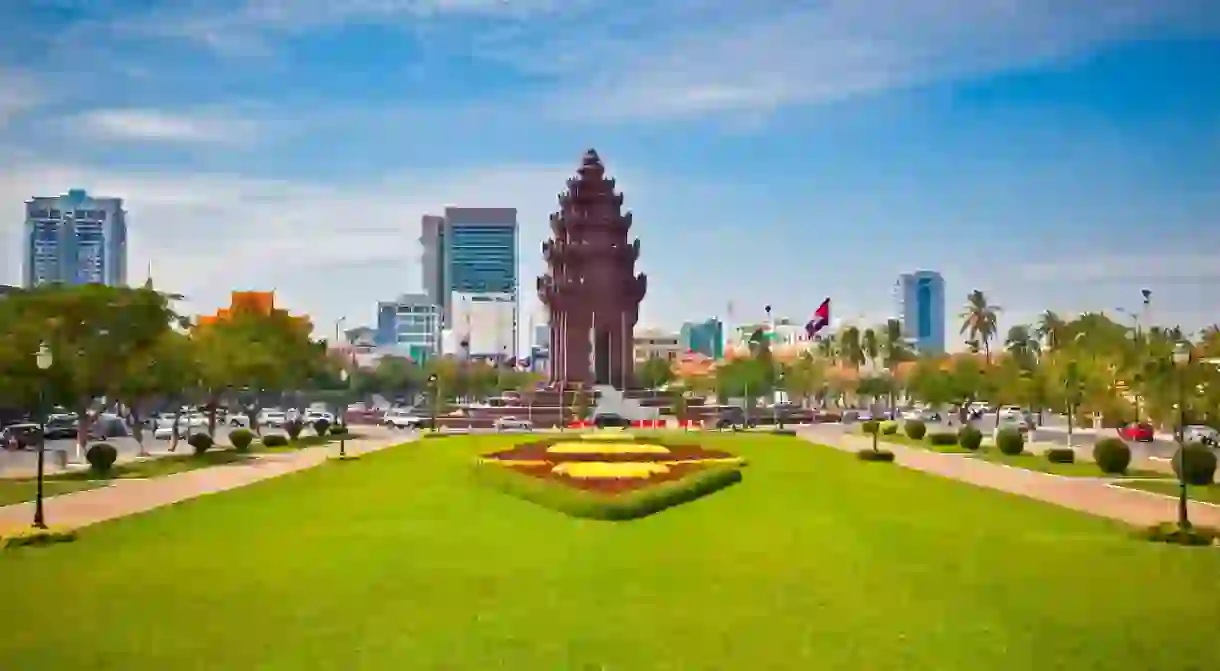Remembering the Works of Vann Molyvann, the Revered Khmer Architect

Revered Khmer architect, Vann Molyvann, died aged 90 at his home in Siem Reap this week (September 28, 2017), leaving a country in mourning. As the mastermind behind many of the country’s modern architectural feats, we look at a handful of his finest works.
Dubbed the Man Who Built Cambodia, Vann Molyvann helped steer Cambodia’s architecture through the Golden Age of the 1950s and 60s, building some of the country’s finest buildings, monuments and structures.
Born in Kampot in 1926, at the age of 20 he was awarded a scholarship to study architecture at Ecole Nationale Supérieure des Beaux-Arts (School of Fine Arts) in the French capital of Paris. A decade later and he returned to his homeland – three years after Cambodia gained independence from France.
His passion and cutting-edge modern approach, influenced by a blend of Le Corbusier’s modernism and the intricate ancient Cambodian details that feature on temples such as Angkor Wat, caught the attention of then King Norodom Sihanouk, who recruited him as state architect.
He went on to design many of the country’s great monuments and buildings, many of which have now been destroyed, as part of a countrywide make-over to modernise the Kingdom of Wonder. He was also at the forefront of the New Khmer Architecture movement. As the country tumbled into turmoil ahead of the 1975 Khmer Rouge take-over, Vann fled to Switzerland in 1971, returning two decades later. He went on to work for an NGO tasked with restoring Angkor Wat.
Here, we look at some of his most memorable architectural feats.

Chaktomuk Conference Hall
This was Vann’s first building as Cambodia’s chief architect, completed in 1961 on Phnom Penh’s riverside. The impressive fan-shaped hall is located close to the Royal Palace, upon which Vann is said to have modelled Chaktomuk’s iconic eight-gabled roofs on. Its design also pays testament to Vann’s intricate eye for detail, with the v-shaped layers, cornices and guardrails all placed to produce playful shadows and streams of light, as well as enable cooling breezes to sweep through the building. The hall remains open today, and is one of only a few of Vann’s well-preserved creations.

Independence Monument
Standing proud in central Phnom Penh is one of Vann’s most widely-known structures. Positioned in line with Wat Phnom, Independence Monument sits at the intersection of two of the capital’s main parades – Norodom and Sihanouk boulevards – and plays an integral part in major ceremonies that take place in the capital today. Vann was commissioned to create the piece in the mid-1950s to celebrate the liberation of Cambodia from French protectorate rule in 1953. On either side of the monument are long stretches of gardens – some of the capital’s only green space. Here, locals can be seen strolling in the dappled shade at dusk or jogging at daybreak.

Olympic Stadium
Established as the National Sports Complex, this spot is referred to today as Olympic Stadium. Built for the second GANEFO event in 1964, the building is modelled on Angkor Wat’s design. Lakes were dug out around the stadium, resembling Angkor’s manmade moats, and the complex built on rising land from the soil. Vann’s modernist vision sees strong lines feature heavily in the aesthetic. The impressive 84,000 seat outdoor arena is also crafted so the rows of seats and mushroom roof act as ventilation for the indoor courts. Today, all kinds of sports are played here, with the concrete amphitheatre filling up with Cambodians carrying out aerobics classes at dusk and dawn. The stadium has since been sold to a Taiwanese company, with it currently overshadowed by construction projects for luxury condos and offices.

Institute of Foreign Languages
This building is New Khmer Architecture at its finest. Vann started designing the then Teacher Training College in 1965. However, it was not completed until after he fled for Switzerland. Melding strong Angkorian design with hints at the modernist movement, the complex is made of elevated walkways, naga statues, columns, borays – or water ways – and skylights for filtered natural light. The buildings today house the Royal University of Phnom Penh’s Institute of Foreign Languages.

Bassac Riverfront Project
Nestled on a large reclaimed stretch of land in Phnom Penh, this ambitious cultural and social project took place between 1962 and 1968, and used the expertise of a string of architects and engineers, including Vann, Gerald Hanning, Vladimir Bodiansky, Robert Hansberger and Vann’s contemporary, Lu Ban Hap. The project took in Olympic Village Apartments, the National Theatre and the Exhibition Hall. Cambodia’s first social housing project was also included in the form of The White Building, which comprised of 468 apartments reserved for lower- to middle-class Cambodians, mainly artists and civil servants. Residents of the dilapidated building were recently relocated and the building demolished.














